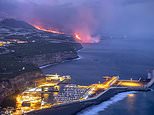Spanish island of La Palma is expanding nearly 550 yards as lava flows into sea
Volcano-hit island of La Palma has grown by almost 550 yards into the sea as lava continues to flow into the Atlantic and hardens
Spanish island of La Palma is expanding as lava from a volcano flows into the sea Lava cools rapidly as it hits water with molten rock build up to 550 yards wideThe volcano has been erupting since Sept. 19 and reached the coast on Tuesday
<!–
<!–
<!–<!–
<!–
(function (src, d, tag){
var s = d.createElement(tag), prev = d.getElementsByTagName(tag)[0];
s.src = src;
prev.parentNode.insertBefore(s, prev);
}(“https://www.dailymail.co.uk/static/gunther/1.17.0/async_bundle–.js”, document, “script”));
<!–
DM.loadCSS(“https://www.dailymail.co.uk/static/gunther/gunther-2159/video_bundle–.css”);
<!–
The Spanish island of La Palma is continuing to expand as lava from a volcano flows into the Atlantic Ocean and hardens as it comes into contact with water, scientists have said.
Since erupting on September 19 the volcano has destroyed more than 800 buildings, as well as banana plantations, roads and other infrastructure.
After meandering downhill to the coast for nearly 10 days, the lava reached the ocean just before midnight on Tuesday a kilometre west of Tazacorte.
On reaching the water, the lava cools rapidly, binding to the cliffside and enlarging the island’s territory and has created a rocky outcrop more than 546 yards wide.
The Spanish island of La Palma is expanding as lava from a volcano flows into the sea, creating an outcrop of molten rock up to 550 yards wide (pictured on Wednesday)
Copernicus, the European Union’s Earth observation programme, said on Thursday that its satellite imagery showed a D-shaped tongue of molten rock building up on the island’s western shore measured 338 hectares (835 acres) by the end of Wednesday.
Trade winds typical of Spain’s Canary Islands were helping dispel the plumes of water vapour and toxic gases that result when the lava, with a temperature of over 1,000C (1,800F), meets the ocean, where the water is 22C (71.6F).
But authorities were on alert as Spain’s weather forecaster, AEMET, indicated that the wind’s direction could change later on Thursday and bring the toxic plumes towards the shore and further inland.
The hydrochloric acid and tiny particles of volcanic glass released into the air can cause skin, eye and respiratory tract irritation.
Satellite imagery show the path of the lava flow as it meandered downhill to the coast for nearly 10 days before it reached the sea, a kilometre west of Tazacorte
Since first erupting on September 19 the volcano has destroyed more than 800 buildings on the island (shown by satellite images, right, before the lava flow reached them)
The direction the lava flow could take was also a source of concern.
Molten fluid emanating from the volcano that first erupted on September 19 was still running downhill like a river and tumbling over a cliff into the Atlantic.
But uneven terrain could make the lava overflow its current path, spread to other areas, and destroy more houses and farmland.
At least 855 buildings and 19 miles (30km) of roads, as well as other key infrastructure, have been wiped out so far.
Banana plantations that are the source of income for many islanders have also been either destroyed or damaged by volcanic ash.
As the lava reaches the ocean it cools rapidly, binding to the cliffside and enlarging the island’s territory and has created a rocky outcrop more than 546 yards wide
More than 6,000 residents have been evacuated so far, and hundreds more were advised to stay at home to avoid the possible inhalation of toxic gases.
Residents of Spain’s La Palma were struggling on Thursday to come to terms with the devastation wrought by the Cumbre Vieja volcano, which has been ejecting a destructive cocktail of ash, smoke and lava for more than 10 days.
La Palma resident Carmen Rodriguez, who lost her home in the village of Todoque, was caught off guard by the advancing column of molten rock and was struggling on Thursday to come to terms with the devastation.
Trade winds typical of Spain’s Canary Islands were helping dispel the plumes of water vapour and toxic gases (pictured on September 30) that result when the lava, with a temperature of over 1,000C, meets the ocean, where the water is 22C
‘We never thought that the volcano was going to reach our house, never,’ she said, recalling how she rushed to salvage belongings during a last-minute evacuation before the lava engulfed her home.
‘There were so many people and difficulties, there was a queue. Thankfully we were able to take the washing machine, the fridge and a cooker that I recently bought.’
‘I only ask that they give us a place to live, that they give us a habitable house, nothing more,’ she said.
No casualties or injuries have been reported among La Palma residents since the eruption began.
La Palma, home to about 85,000 people, is part of the volcanic Canary Islands, an archipelago off northwest Africa. The island is roughly 22 miles (35km) long and 12 miles (20km) wide at its broadest point.
![]()


